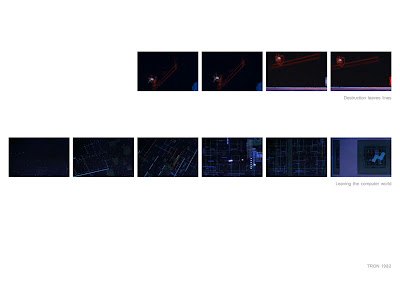There were three designers used to create the computer world. Jean Giraud, a French comic book artist, designed the main set and costumes. Peter Lloyd, a high tech commercial artist, designed the environments. Syd Mead designed the vehicles.
Disney was approached in 1980 as they were interested in producing more daring productions. Disney agreed they were interested so a test reel was ran and they agreed they would back the production. In 1981 Tron was filmed in 65mm super Panavision due to the number of special effects. Back lit animation was a process used to create the live action scenes. The scenes were created inside the computer filmed in black and white on an entirely black set. The films were then printed on a large format Kodalith high contrast film which was the colourised with photographic and rotoscopic techniques which gave a " technological feel". This then produced high contrast, large format positives and negatives. This required lots of sheets of film and a larger workload than that of a conventional cel-animated feature. Whilst the sheets of film were being delivered there was a confusion with a batch which was still printed on leading to glowing outlines and circuit traces occasionally flickering parts as the film speed varied between batches. After the problem was discovered, it was decided that it was not going to be a problem as sounds were placed over these parts to make it look as if the computer world was malfunctioning.
More than 500 people were involved in the post-production work, including 200 inker and hand-painters in Taiwan's Cuckoo's Nest Studio.
I have watched the film and simply identified parts of the film where I think they are most relevant in what I am doing. These have then been cut into stills. The main aim of watching the film was to look at how the negatives and positives of space have been created using light.
Most of the screen shots that I have taken from Tron are how the space has been defined by light. The film has created a negative and positive simply by using a black set to film and then the neon lights to highlight the detail or boundary of an object or space. The construction of ships and objects is shown in something similar to a stop motion animation; for example when the ship was found in blocks, as it raises up in the air, piece by piece of the ship comes together. When we enter and leave the computer world we fly through the space, so we pass through all levels of light. It sometimes spins and turns direction leading us to see new formations of lights each time. The lighting arrangement is representing a city as we fly towards and away from it. At the end once we have left the computer world we watch a real city transform in light quality from day-light to night-time which brings us back to reality.








No comments:
Post a Comment